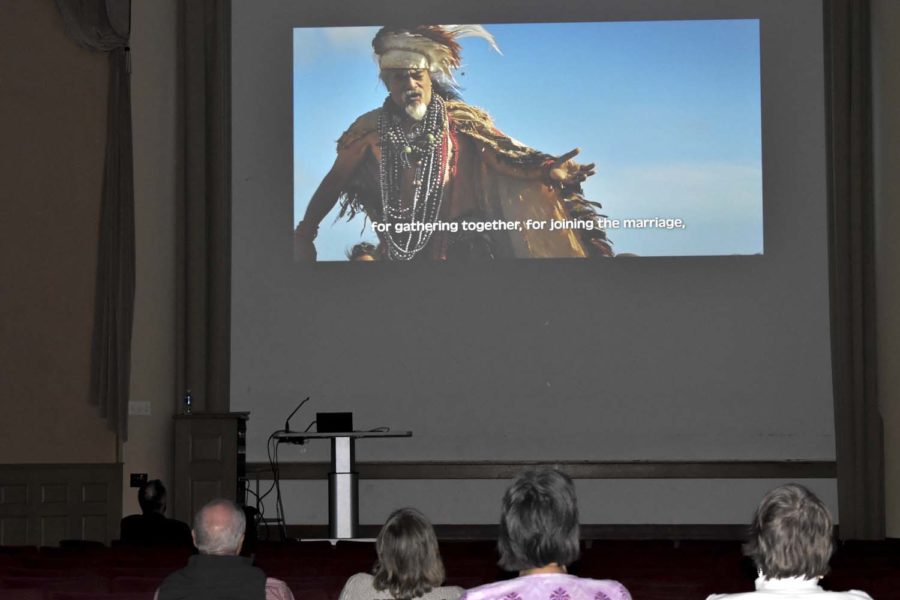Dig deep with the Arkhaios archaeology film festival
Romita Das | Staff Photographer
The Arkhaios Film Festival aims to educate the public on new developments in archaeology and provide a platform for independent films.
November 5, 2019
Most Pittsburgh residents’ knowledge of archaeological films likely doesn’t extend beyond the “Indiana Jones” movies.
That might have changed when the Arkhaios Film Festival came to the Frick Fine Arts building Saturday and Sunday, screening a series of nine documentaries focused on archaeology and cultural heritage. The festival, which was founded in 2013, has been hosted at Pitt for the past three years and is sponsored in part by the department of anthropology.
According to the Arkhaios website, the event aims to educate the public on new developments in archaeology and provide a platform for less-recognized independent films, which, while culturally significant, are often not typically commercially successful.
Jean Gilleux, the festival director and founder, said he recognized the need for an American archaeological film festival while on an excavation in France, where he researched the paleolithic Solutrean people. There, he attended an archaeological film festival, and discovered that universities and museums across Europe held several each year. Upon returning to the United States, he said he was disappointed to learn that the only such American festival was held exclusively in Eugene, Oregon.
“I said, ‘OK, we’ve got to do something about [the lack of festivals in America],’” Guilleux said. “And that’s how Arkhaios was started.”
Before the festival arrived at Pittsburgh this year, the entries were screened in front of a committee of 22 academics and media professionals 一 including archaeologists, historians and filmmakers 一 who decided on the official selection. This selection then screened at the University of South Carolina in early October, where a jury of five anthropologists and filmmakers awarded prizes to the best films, such as “Eating Up Easter” directed by Sergio Mata’u Rapu, which won the festival’s grand prize.
The selections screened this past weekend contained many winners of the South Carolina festival with a few notable exceptions. The South Carolina festival showed several films related to underwater archaeology, as the University of South Carolina specializes in maritime archaeology. In addition, each festival showed films related to state history. Films pertinent to South Carolina’s cultural heritage were not screened in Pennsylvania and vice versa.
The Pittsburgh festival opened with the winner of the award for best archaeology film — “Neanderthal, the Mystery of the Bruniquel Cave,” which was directed by journalist and filmmaker Luc-Henri Fage and originally produced in French.
The film follows a team of researchers as they explore a cave in southwestern France containing man-made stalagmite structures. The team is shocked to discover that they are approximately 176,000 years old — making them the oldest man-made structures ever discovered underground.
The film premiered earlier in 2019 on Arte — a European TV channel offering cultural programming — where it amassed more than a million views. Fage wrote the English subtitles himself in order to meet the deadline to enter the film in the Arkhaios festival.
According to the film, this discovery has major implications for anthropologists’ understanding of neanderthals. It indicates that these early hominids, who lived alongside modern man, likely had the capacity to think symbolically and organize themselves in a way once thought exclusive to Homo sapiens.
Karl Thomas and Jean-Dominique Le Garrec, Pittsburgh residents and friends of Guilleux, attended the festival and said they found the new evidence supporting the advanced development of neanderthals particularly moving. Le Garrec, a resident of Squirrel Hill, said he thought films like Fage’s appeal to our desire to understand human history.
“It’s the story of humanity,” he said. “We are all interested in knowing our environment.”
Thomas, 49, of East Liberty, said he was reminded of a film he saw a few years before on prehistoric cave paintings in the south of France. He said both films fascinated him because they showed that most people’s views of cavemen as primitive and undeveloped are highly mistaken 一 even the great artists of our own age look to our prehistoric ancestors for inspiration.
“The best artists in the world studied [these cave paintings],” he said. “[People] thought that we had bettered ourselves, that we had advanced … but these artists thought that 20 million years ago, men were just as good as artists as they are in this era.”
Other films at the festival explored issues of the preservation of traditional cultures in a rapidly modernizing world. Native Rapa Nui director Rapu investigates the effects of tourism on his home of Easter Island in the film “Eating Up Easter.” He follows the stories of several Rapa Nui individuals as they combat increasing pollution, the loss of Native art forms and the commodification of their culture by white tourists.
Also featured at the festival were two films about Pennsylvania’s history. “Digging Deep: Buried Landscapes of Pennsylvania” was produced and directed by Angela Jaillet-Wentling, a historic preservation specialist for the Pennsylvania Department of Transportation.
Jaillet-Wentling explores the legacy of the 1966 National Historic Preservation Act, which has led to the discovery of several historically and culturally significant archaeological sites across Pennsylvania. Meanwhile, “Hot Rock Boiling,” directed by Brian Fritz, follows the efforts of an IUP graduate student to recreate the Native American cooking traditions of Western Pennsylvania.
The films at Arkhaios covered a wide range of material, a fact in which Guilleux takes deep pride. He said he enjoys being able to present a wealth of subject matter in a short time frame.
“[The films] are from all around the world,” he said. “It goes from a cave in France, to Pachacamac in Peru, to Versailles, to Canada, to Easter Island.”








